One of the directions of the Great Silk Road crossed the Ili Valley and led to China, Japan, Central Asia, Iran, and Byzantium. The settlement of Talhiz (another name – Talhir) was named among of the North-Eastern Zhetysu settlements in the geographical treatise of the Persian geographer “Hu-dud al-Alem” (“Borders of the World”, 982). The medieval city of Talgar (Talkhiz), located in the foothills, became one of the most important trade points on the route of the Great Silk Road, which became the catalyst for the economic and economic growth of the city and its trades.


Today only the central part of the town remains: the citadel measuring 298×302 m (9 hectares), surrounded by perimeter walls with small manmade hills, the remains of a fortification towers. While, according to the historical sources, in 980 the area of the city was 28 hectares. Archaeological excavations of the town begin in the mid-1950es under the direction of I.I. Kopylov. The large-scale study of the monument began in the second half of the 1960’s, when a special detachment was formed under the leadership of K.M. Baipakov to study the settlement and urban culture, as part of the Semirechie Archaeological Expedition led by K. Akisheva.
The Talgar detachment conducted excavations in 1968 and 1970. In 1978 the excavations were renewed after a break as part of the South Kazakhstan Complex Archaeological Expedition (SKCAE); and later within the Almaty Expedition, and then again as part of the SKCAE, where the Talgar detachment worked under the leadership of T.V. Savelyeva. In 1978–1983 trenches were excavated in the town of Talgar with a total area of 3890 sq.m on the territory of the central part and on the land plots adjacent to the south, which included the town districts, 12 houses, and a 65 meter-long section of the main street. The research continued on the site in 1986, where two more manors and a part of the craftsman’s workshop were excavated. The1990–1993 research was mainly focused on a number of central sites.


The monument excavations were reopened in 2018 under the management of T.V. Savelyeva within the framework of the “Paleoeconomics of the Ili Valley’s medieval cities” Project. Archaeological excavations were carried out on the eastern quarter of the town’s citadel. During the research a few households were unearthed, consisting of several facilities. In many of them there were found preserved sufas (resting platforms made of clay) with built-in tandoor ovens, also ovens with chimneys, and a large number of ceramic fragments. A section cut was made in the eastern fortress wall to study its parameters and building methods.
